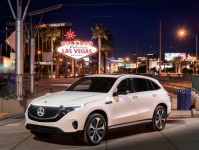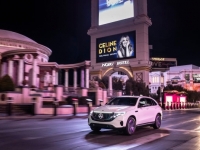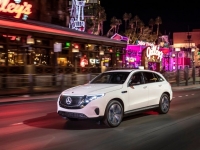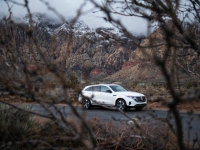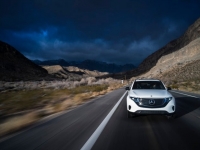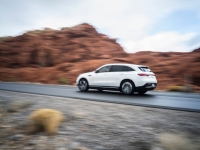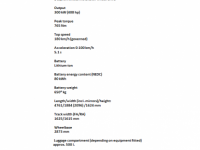Automobiles
USA premiere of the new Mercedes-Benz EQC
Mercedes-Benz among electric vehicles
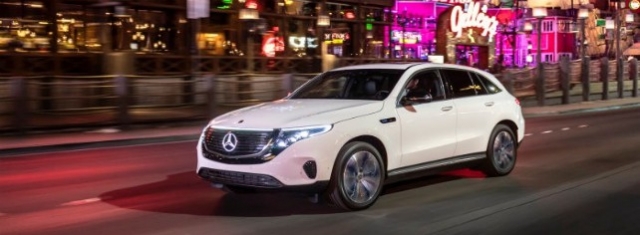
Mercedes-Benz EQC (Source: © 2019 Daimler AG. All rights reserved.)
USPA NEWS -
At CES 2019 in Las Vegas the first Mercedes-Benz vehicle from the EQ brand is celebrating its US premiere. The EQC (combined power consumption: 22.2 kWh/100 km; CO2 emissions combined: 0 g/km, provisional details)[1] symbolises the beginning of a new mobility era at Daimler. With its seamless, clear design and colour highlights typical of the brand, it is a pioneer for an avant-garde electric look while representing the design idiom of Progressive Luxury. With respect to quality, safety and comfort the EQC is the Mercedes-Benz among electric vehicles, and highly convincing in the sum of its attributes. These elements are accompanied by dynamic performance, thanks to two electric motors at the front and rear axles with a combined output of 300 kW. Thanks to an ingenious operation strategy, the EQC has a preliminary range of 450[1] kilometres (279 miles) according to the European cycle NEDC. EQ also offers comprehensive services with Mercedes me, and makes electromobility convenient and suitable for day-to-day motoring.
As the first Mercedes-Benz model under the new product and technology brand EQ, the Mercedes-Benz EQC has many trailblazing design details and colour highlights typical of the brand. Both inside and out, the EQC embodies the design idiom of Progressive Luxury. This arises from the combination of a previously unknown beauty, the conscious clash of digital and analogue elements as well as the seamless merging of intuitive and physical design.
By virtue of its muscular proportions, the EQC is classed as a crossover SUV. The extended roofline and window layout with a low waistline and the coupé-like roof recess at the rear visually position it between an SUV and an SUV coupé.
By virtue of its muscular proportions, the EQC is classed as a crossover SUV. The extended roofline and window layout with a low waistline and the coupé-like roof recess at the rear visually position it between an SUV and an SUV coupé.
Star Car: putting on a big show with the Night Design
A striking feature at the front is the large black-panel surface enclosing the headlamps and grille. Exclusively for the American market the large Mercedes star on the panel is illuminated at night as standard and for the first time it can also be combined with the radar-controlled DISTRONIC. This ensures a particularly impressive look in darkness. The Night Design is also unique thanks to the inclusion of the fibre-optic cable for the first time. As the finishing touch to the top of the Black Panel it provides a visual link to the characteristic Mercedes“‘Benz daytime running lights. This creates an almost uninterrupted, horizontal light band. The inner housings and tubes of the standard MULTIBEAM LED headlamps are in high-gloss black. Contrasting colour highlights discreetly confirm the model's membership of the new EQ family: blue stripes on a white background, and MULTIBEAM lettering also in blue.
A striking feature at the front is the large black-panel surface enclosing the headlamps and grille. Exclusively for the American market the large Mercedes star on the panel is illuminated at night as standard and for the first time it can also be combined with the radar-controlled DISTRONIC. This ensures a particularly impressive look in darkness. The Night Design is also unique thanks to the inclusion of the fibre-optic cable for the first time. As the finishing touch to the top of the Black Panel it provides a visual link to the characteristic Mercedes“‘Benz daytime running lights. This creates an almost uninterrupted, horizontal light band. The inner housings and tubes of the standard MULTIBEAM LED headlamps are in high-gloss black. Contrasting colour highlights discreetly confirm the model's membership of the new EQ family: blue stripes on a white background, and MULTIBEAM lettering also in blue.
The high-quality interior of the EQC also pioneers an avant-garde electro-look. One example is the louvred edge of the instrument panel, which resembles the cooling ribs of a hi-fi amplifier. The instrument panel is designed as a driver-oriented cockpit. The typical Mercedes-Benz wing profile is asymmetrical, with a "cut-out" in the driver area. This is where one of the visual highlights of the cockpit is located - a high-tech, high gloss cassette housing flat air vents with key-shaped, rosé-gold coloured louvres.
Powertrain: Dynamic performance meets efficiency
As the first Mercedes-Benz model to be launched under the new product and technology brand EQ, the EQC features an all-new drive system development with compact electric drivetrains at each axle. These give the EQC the driving characteristics of an all-wheel drive.
To reduce power consumption and increase dynamism, the electric drivetrains are configured differently: the front electric motor is optimised for best possible efficiency in the low to medium load range, while the rear one determines dynamism. Together, they generate an output of approx. 300 kW and a combined maximum torque of 765 Nm.
Mercedes-Benz engineers have enhanced noise comfort with a number of measures. In the EQC the powerpacks are isolated by rubber mounts at two points: where the powerpack connects to its subframe and where the subframe connects to the body. This effective isolation is supplemented with insulation measures. As a result, the interior of the EQC is extremely quiet.
As the first Mercedes-Benz model to be launched under the new product and technology brand EQ, the EQC features an all-new drive system development with compact electric drivetrains at each axle. These give the EQC the driving characteristics of an all-wheel drive.
To reduce power consumption and increase dynamism, the electric drivetrains are configured differently: the front electric motor is optimised for best possible efficiency in the low to medium load range, while the rear one determines dynamism. Together, they generate an output of approx. 300 kW and a combined maximum torque of 765 Nm.
Mercedes-Benz engineers have enhanced noise comfort with a number of measures. In the EQC the powerpacks are isolated by rubber mounts at two points: where the powerpack connects to its subframe and where the subframe connects to the body. This effective isolation is supplemented with insulation measures. As a result, the interior of the EQC is extremely quiet.
The lithium-ion battery, which has an energy content of 80 kWh (NEDC), supplies the vehicle with power. The power consumption and range of electric vehicles greatly depend on the driving style. The EQC supports its driver with five driving programs, each with different characteristics: COMFORT, ECO, MAX RANGE, SPORT and an individually adaptable program. In the more economical driving modes, the haptic accelerator pedal that prompts the driver to conserve power plays an important role. The driver is also able to influence the recuperation level using so-called paddles behind the steering wheel.
The ECO Assist system gives the driver comprehensive support when driving predictively: by prompting the driver when it is appropriate to come off the accelerator, e.g. because the vehicle is approaching a speed limit, and by functions such as coasting and specific control of recuperation. For this purpose, navigation data, traffic sign recognition and information from the intelligent safety assistants (radar and stereo camera) are linked and processed.
The ECO Assist system gives the driver comprehensive support when driving predictively: by prompting the driver when it is appropriate to come off the accelerator, e.g. because the vehicle is approaching a speed limit, and by functions such as coasting and specific control of recuperation. For this purpose, navigation data, traffic sign recognition and information from the intelligent safety assistants (radar and stereo camera) are linked and processed.
Charging: Flexible and fast
As standard the EQC is equipped with a water-cooled onboard charger (OBC) with a capacity of 7.4 kW, making it suitable for AC charging at home or at public charging stations.
Within the EU the charging process at a Mercedes-Benz Wallbox is up to three times faster than at a household socket; in the USA the time advantage when charging at a Wallbox is even up to eight times as much, because here the voltage at a household socket is usually 120 V. It is faster still with DC charging ““ which is standard for the EQC, with a suitable market-specific plug ““ for example via CCS (Combined Charging Systems) in Europe and the USA, CHAdeMO in Japan or GB/T in China. Depending on the SoC (status of charge), the EQC can be charged with a maximum output of up to 110 kW at an appropriate charging station. It then takes around 40 minutes to charge from 10 to 80 percent SoC (provisional figures).
As standard the EQC is equipped with a water-cooled onboard charger (OBC) with a capacity of 7.4 kW, making it suitable for AC charging at home or at public charging stations.
Within the EU the charging process at a Mercedes-Benz Wallbox is up to three times faster than at a household socket; in the USA the time advantage when charging at a Wallbox is even up to eight times as much, because here the voltage at a household socket is usually 120 V. It is faster still with DC charging ““ which is standard for the EQC, with a suitable market-specific plug ““ for example via CCS (Combined Charging Systems) in Europe and the USA, CHAdeMO in Japan or GB/T in China. Depending on the SoC (status of charge), the EQC can be charged with a maximum output of up to 110 kW at an appropriate charging station. It then takes around 40 minutes to charge from 10 to 80 percent SoC (provisional figures).
The EQC features the innovative multimedia system MBUX - Mercedes-Benz User Experience - which has numerous EQ-specific functions such as the display of range, charge status and energy flow. EQ-optimised navigation, driving modes, charging current and departure time can also be controlled and set via MBUX.
The MBUX display has a special EQ icon where numerous EQ features are grouped. Alternatively the user can access the EQ menu of the MBUX system directly using a key in the lower left control panel. Thanks to natural language recognition, the EQ-specific voice control helps the driver to operate the EQC.
MBUX Interior Assist: an even greater experience
By recognising movements MBUX Interior Assist brings added intelligence to the interior. Thanks to innovative technology, MBUX now supports the occupants by making various comfort and MBUX functions even simpler and more intuitive. Interior Assist operates in non-contact mode and functions both in sunlight and in complete darkness.
It enables the adaptation of screen content as soon as a hand approaches the touchscreen in the dashboard or the touchpad on the centre console, for example. Individual elements are highlighted according to the currently active menu. In addition, the system is able to distinguish between the driver's and front passenger's wishes and thus knows for whose seat the seat heating is to be activated, for example.
By recognising movements MBUX Interior Assist brings added intelligence to the interior. Thanks to innovative technology, MBUX now supports the occupants by making various comfort and MBUX functions even simpler and more intuitive. Interior Assist operates in non-contact mode and functions both in sunlight and in complete darkness.
It enables the adaptation of screen content as soon as a hand approaches the touchscreen in the dashboard or the touchpad on the centre console, for example. Individual elements are highlighted according to the currently active menu. In addition, the system is able to distinguish between the driver's and front passenger's wishes and thus knows for whose seat the seat heating is to be activated, for example.
A special feature of Interior Assist is the personal favourites function. The driver and front passenger can both program a personal, favourite function which is initiated using a horizontally outstretched index and middle finger. In this way, any command which is controllable via MBUX can be stored for simple access. One typical favourite command is "navigate me home". The system is also in a position to detect reliably whether it is being operated by the driver or front passenger. This even means that they can each assign their own different favourites with the same hand position.
There are other functions which can be controlled intuitively, without any need to practise corresponding gestures: In the dark, the reading lamp can be switched on and off by briefly extending a hand towards the rear-view mirror, for example. If the driver reaches over towards the (unoccupied) front passenger seat in the dark, it will be illuminated automatically. This makes it easier to find any items which may have been deposited on the seat. As soon as the person's hand leaves this area, the light automatically switches off again.
There are other functions which can be controlled intuitively, without any need to practise corresponding gestures: In the dark, the reading lamp can be switched on and off by briefly extending a hand towards the rear-view mirror, for example. If the driver reaches over towards the (unoccupied) front passenger seat in the dark, it will be illuminated automatically. This makes it easier to find any items which may have been deposited on the seat. As soon as the person's hand leaves this area, the light automatically switches off again.
Intelligent services: Relaxed travel from start to finish
EQ with Mercedes me provides comprehensive services for the electric mobility of today and tomorrow. The most important new services and functions of the EQC planned for market launch include:
Pre-entry climate control: This ensures that the vehicle interior is already at the desired temperature on departure. It can be programmed directly via MBUX or via the Mercedes me app. A sophisticated system with a heat pump and electric heater boosters pre-climatises the interior.
EQ optimised navigation always bases its calculation on the fastest route taking into account the shortest charging time and the topography. The route planning also responds dynamically to changes, and can take place both offboard and onboard, i.e. externally (via the Mercedes me App) and within the vehicle. Thanks to EQ-optimised navigation, Mercedes-Benz customers can easily find charging stations, and Mercedes me Charge gives them convenient access to the charging stations of numerous providers, also beyond national borders. Customers benefit from an integrated payment function with simple invoicing.
EQ with Mercedes me provides comprehensive services for the electric mobility of today and tomorrow. The most important new services and functions of the EQC planned for market launch include:
Pre-entry climate control: This ensures that the vehicle interior is already at the desired temperature on departure. It can be programmed directly via MBUX or via the Mercedes me app. A sophisticated system with a heat pump and electric heater boosters pre-climatises the interior.
EQ optimised navigation always bases its calculation on the fastest route taking into account the shortest charging time and the topography. The route planning also responds dynamically to changes, and can take place both offboard and onboard, i.e. externally (via the Mercedes me App) and within the vehicle. Thanks to EQ-optimised navigation, Mercedes-Benz customers can easily find charging stations, and Mercedes me Charge gives them convenient access to the charging stations of numerous providers, also beyond national borders. Customers benefit from an integrated payment function with simple invoicing.
Active and passive safety: EQC-specific safety concept
The EQC is equipped with the latest generation of Mercedes-Benz driving assistance systems. In the Driving Assistance package, these include new functions such as predictive speed adjustment when approaching the end of a tailback: when a tailback is detected, Active Distance Assist DISTRONIC reduces the speed to around 100 km/h as a precaution. In a tailback on the motorway, the lane guidance system keeps the vehicle off-centre to leave space for the emergency services.
The EQC also meets the highest requirements with respect to passive safety: in addition to the usual, extensive programme of crash tests, Mercedes-Benz applies further, particularly stringent safety standards to the battery and all component parts carrying electrical current. These standards exceed legal requirements. The vehicle structure of the EQC has been adapted to suit the special requirements of the electrical components and battery, and is configured to achieve the usual high safety level. For example, a new subframe surrounds the drive components located in the front section, and this unit is supported by the usual mounting points.
The EQC is equipped with the latest generation of Mercedes-Benz driving assistance systems. In the Driving Assistance package, these include new functions such as predictive speed adjustment when approaching the end of a tailback: when a tailback is detected, Active Distance Assist DISTRONIC reduces the speed to around 100 km/h as a precaution. In a tailback on the motorway, the lane guidance system keeps the vehicle off-centre to leave space for the emergency services.
The EQC also meets the highest requirements with respect to passive safety: in addition to the usual, extensive programme of crash tests, Mercedes-Benz applies further, particularly stringent safety standards to the battery and all component parts carrying electrical current. These standards exceed legal requirements. The vehicle structure of the EQC has been adapted to suit the special requirements of the electrical components and battery, and is configured to achieve the usual high safety level. For example, a new subframe surrounds the drive components located in the front section, and this unit is supported by the usual mounting points.
Mechanical protection of the battery: the high-safety design begins with the installation position of the high-voltage battery beneath the vehicle floor. The energy storage unit is surrounded by a stable frame that can absorb energy. Deformation elements are installed between the frame and the battery, and these are able to absorb additional forces in the event of a severe side impact. A battery guard in the front area of the battery is able to prevent the energy storage unit from being pierced by foreign objects.
Electrical protection of the high-voltage system: the extensive experience of Mercedes-Benz with high-voltage drive systems has led to a multi-stage safety concept that deploys in the event of an accident. The high-voltage system automatically shuts down, reversibly or irreversibly, according to the severity of the accident. There are also shutdown points where emergency teams can deactivate the high-voltage system manually.
Electrical protection of the high-voltage system: the extensive experience of Mercedes-Benz with high-voltage drive systems has led to a multi-stage safety concept that deploys in the event of an accident. The high-voltage system automatically shuts down, reversibly or irreversibly, according to the severity of the accident. There are also shutdown points where emergency teams can deactivate the high-voltage system manually.
Testing: Endurance tests around the world
By market launch, 200 prototypes and pre-production vehicles of the EQC will have absolved tests covering several million kilometres across four continents (Europe, North America, Asia and Africa). The test program comprises more than 500 individual tests. Like all Mercedes-Benz vehicles, the EQC must absolve the demanding standard test programme. There are also special tests for the electric powertrain, the fuel cell, and the interplay of all powertrain components.
In the process the test experts are able to build upon the extensive findings from their digital testing work, used to ensure both the buildability of the vehicle and for the simulation of e.g. crash behaviour, aerodynamics and NVH: noise, vibration, harshness . In addition there are intensive tests on numerous test rigs at the Mercedes-Benz Technology Centre in Sindelfingen. The ratio between digital and real testing is roughly 35 to 65 percent.
By market launch, 200 prototypes and pre-production vehicles of the EQC will have absolved tests covering several million kilometres across four continents (Europe, North America, Asia and Africa). The test program comprises more than 500 individual tests. Like all Mercedes-Benz vehicles, the EQC must absolve the demanding standard test programme. There are also special tests for the electric powertrain, the fuel cell, and the interplay of all powertrain components.
In the process the test experts are able to build upon the extensive findings from their digital testing work, used to ensure both the buildability of the vehicle and for the simulation of e.g. crash behaviour, aerodynamics and NVH: noise, vibration, harshness . In addition there are intensive tests on numerous test rigs at the Mercedes-Benz Technology Centre in Sindelfingen. The ratio between digital and real testing is roughly 35 to 65 percent.
Production: Preparations in full swing in the Bremen plant
Production of the EQC will start in 2019 at the Mercedes-Benz plant in Bremen. The preparations for this are already fully under way. The new EQC will be integrated into ongoing series production as a fully electric vehicle. The very latest production technologies will be employed.
One decisive innovation is the so-called battery-joining centre where the EQC undergoes a second "marriage" following installation of the two electric powerpacks in the bodyshell. This is where the EQCs are recognised as electric models with the help of data tags attached to the body, and equipped with a battery. The body is suspended from a so-called C-carrier and deposited on a frame. Support arms raise the battery to the vehicle's floor from below. An employee monitors the automatic bolting in place.
In parallel with this, production of our own batteries for the EQC is coming on stream at the expanded battery plant in Kamenz (near Dresden).
Alongside Bremen, the Sino-German production joint venture Beijing Benz Automotive Co. Ltd. (BBAC) is also preparing for the production start-up of the EQC for the local market.
Production of the EQC will start in 2019 at the Mercedes-Benz plant in Bremen. The preparations for this are already fully under way. The new EQC will be integrated into ongoing series production as a fully electric vehicle. The very latest production technologies will be employed.
One decisive innovation is the so-called battery-joining centre where the EQC undergoes a second "marriage" following installation of the two electric powerpacks in the bodyshell. This is where the EQCs are recognised as electric models with the help of data tags attached to the body, and equipped with a battery. The body is suspended from a so-called C-carrier and deposited on a frame. Support arms raise the battery to the vehicle's floor from below. An employee monitors the automatic bolting in place.
In parallel with this, production of our own batteries for the EQC is coming on stream at the expanded battery plant in Kamenz (near Dresden).
Alongside Bremen, the Sino-German production joint venture Beijing Benz Automotive Co. Ltd. (BBAC) is also preparing for the production start-up of the EQC for the local market.
[1] Figures for power consumption and CO2 emissions are provisional and were determined by the German Technical Service. The range figures are also provisional. EC type approval and a certificate of conformity with official figures are not yet available. Differences between the stated figures and the official figures are possible.
[2] Figures for power consumption and CO2 emissions are provisional and were determined by the German Technical Service. The range figures are also provisional. EC type approval and a certificate of conformity with official figures are not yet available. Differences between the stated figures and the official figures are possible.
[2] Figures for power consumption and CO2 emissions are provisional and were determined by the German Technical Service. The range figures are also provisional. EC type approval and a certificate of conformity with official figures are not yet available. Differences between the stated figures and the official figures are possible.
more information: https://www.mercedes-benz.com/en/mercedes-benz/vehicles/passenger-cars/eqc/the-eqc/
Liability for this article lies with the author, who also holds the copyright. Editorial content from USPA may be quoted on other websites as long as the quote comprises no more than 5% of the entire text, is marked as such and the source is named (via hyperlink).

